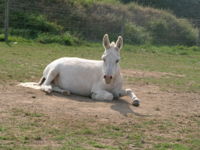
Opioids (e.g. butorphanol, buprenorphine) are classified either as (full) agonists, agonist-antagonists (partial agonists) or antagonists based on differing affinities and efficacy at μ-, κ- and δ-opioid receptors, which results in activation of descending inhibitory pathways and reduction in the transmission of nociceptive signals to higher centres in the brain. Opioid receptors are widespread, resulting in a wide range of side effects including respiratory depression, increased intracranial pressure, hypotension and inhibition of peristalsis, which vary depending on the agent used.
Butorphanol (a κ-agonist-μ-antagonist), one of the most commonly used opioids in equines, produces ataxia, decreased gastrointestinal motility and decreased defecation and short-lasting, mild increases in heart rate and blood pressure in equines. The combination of an opioid with a sedative, such as ACP or an α2 agonist, provides very good quality standing restraint whilst reducing some of the CNS side effects, e.g. excitation and increased locomotion.
The neuroleptanalgesic combination of the potent opioid etorphine with the phenothiazine ACP should NOT be used in donkeys.
References
- Horspool, L. (2008) Clinical pharmacology In Svendsen, E.D., Duncan, J. and Hadrill, D. (2008) The Professional Handbook of the Donkey, 4th edition, Whittet Books, Chapter 12
|
|
This section was sponsored and content provided by THE DONKEY SANCTUARY |
|---|